When company comes and I want to create some atmosphere with a table arrangement, I eschew the offerings at the local supermarkets and opt to swing through my gardens, snipping branches, gathering what I need to make an artful centerpiece that takes minutes to prepare.
Woody shrubs and trees with interesting bark or persistent fruits are worth adding to the landscape — not only for their seasonal interest outdoors but for their usefulness in getting your home spruced up for winter holidays and informal gatherings.
One of my favorite trees for winter interest is the multitrunked
river birch (
Betula nigra 'Heritage'). It makes a dramatic statement with its textured bark, which exfoliates in rich layers of silver, ash, cinnamon and burnt umber. I've added this tree to a birch grove and enjoy its colorful structure from inside my home; it's not something I usually snip, due to its size and scale, but I do gather small birch branches from the woods near my home to stuff in outdoor planters by the front door with seasonal greens.
Here are some other shrubs and plants I like to cut for easy style.
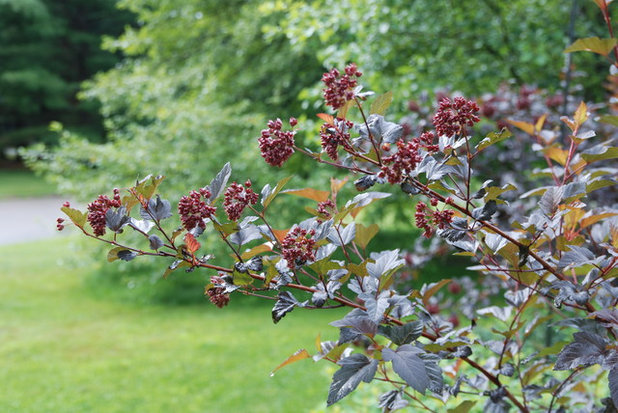
Paintbox Garden
Eastern Ninebark(
Physocarpus opulifolius 'Diablo')
Common name: Purple ninebark
In my Vermont garden, purple ninebark holds its leaves longer than any other deciduous shrub. All parts of the shrub are densely colored, and its bronzed purple foliage and dark stems make this a great selection for tall arrangements. Even the dessicated flower heads are interesting, providing some texture.
Combine cut stems with snips of annual coleus in shades of chartreuse, burgundy and magenta.
USDA zones: 2 to 7 (find your zone)
Water requirement: Average
Light requirement: Full sun
Mature size: 8 feet tall with a 5-foot spread
Planting tips: Shrubs are adaptable and transplant easily. When they're mature, cut them to the ground in late winter to rejuvenate the plants and maintain the compact size. Purple ninebark is a good choice for mixed borders and hedgerows.
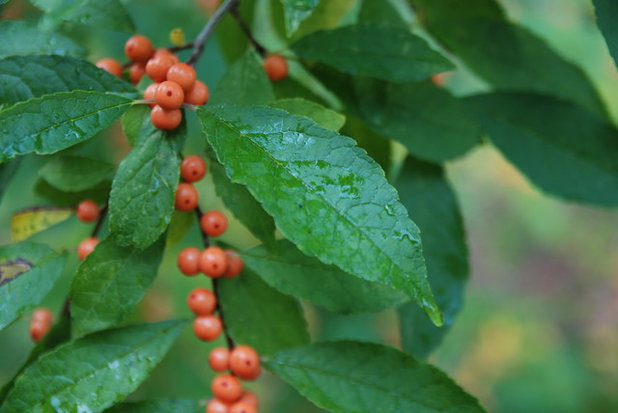
Paintbox Garden
Winterberry(Ilex verticillata)Winterberry makes a show when planted in masses along a woodland edge. The cultivar shown here is 'Winter Gold', which has unusual orange fruit that hits its peak color in November and is most eye catching after the leaves have dropped. Adaptable to wet conditions and poor soils, winterberry is superfunctional and has knockout good looks.
When cutting branches, handle with caution, as the berries easily fall off the stem.
USDA zones: 3 to 9
Water requirement: Moist to wet soil; tolerates swales and bogs
Light requirement: Full sun to partial shade
Planting tips: The species is dioecious, which means there are male plants (pollinators) and females (fruiting); both are needed for fruit. Make sure your female has the correct male partner planted nearby. Mass female plants for best effect during the winter season.
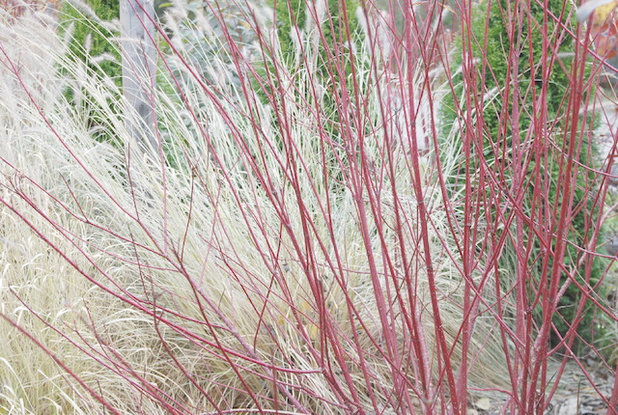
Paintbox Garden
Redosier Dogwood(Cornus sericea)With its wine-red branches, redosier dogwood makes a great clump-forming shrub for a wildlife border or hedge.
C. 'Baileyi' is shown here in the foreground with a spray of fountain grass
(Pennisetum alopecuroides) providing great contrast.
Cut the stems and combine them with evergreen boughs in containers outside your doors, or tie small bundles together with twine and lay them over dinner plates for premeal decor.
Also called redtwig dogwood, this shrub is notable for showy red stems that stand out in the landscape.
USDA zones: 2 to 7
Water requirement: Moist to wet soil; tolerates poor soils
Light requirement: Full to partial sun
Planting tips: Relatively fast growing, this multistemmed shrub can benefit from hard pruning when mature to promote new growth and contain the spread. Be aware that it's stoloniferous; allow room for it to grow. It makes an excellent naturalistic hedge.
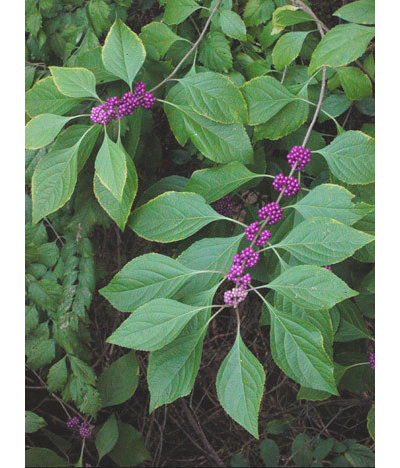
Paintbox Garden
American Beautyberry(Callicarpa americana)For those who love purple, nothing beats beautyberry. Shown here is American beautyberry, which makes an appropriate choice for naturalistic settings among other U.S. natives, like Virginia sweetspire and panic grass. It is a multistemmed shrub that produces clusters of purple fruit in the fall.
Look also for Japanese beautyberry
(C. japonica) 'Heavy Berry', which has a pronounced fruit set, or the white-fruited variety
C. japonica 'Leucocarpa'.
USDA zones: 6 to 11
Water requirement: Moist, well-drained soil
Light requirement: Full to partial sun
Mature size: 3 to 8 feet high; clump forming
Planting tips: Use this species in mass plantings for high-wattage effects. It forms loose, spreading clumps that can be hard pruned every few years to maintain good form.
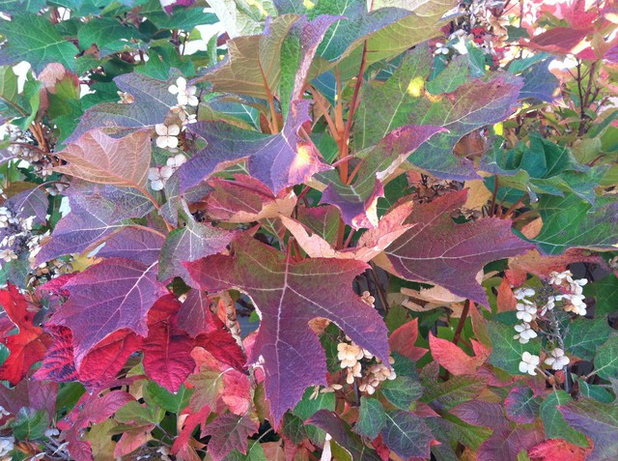 Oakleaf Hydrangea(Hydrangea quercifolia)
Oakleaf Hydrangea(Hydrangea quercifolia)Hands down, oakleaf hydrangea has it all: peeling bark with light caramel hues, deeply lobed leaves that turn russet with the first frosts and a rugged personality that's easy to love. Think "rustic lodge" when making arrangements with these branches — use old sap buckets, antique pitchers or glazed ceramic vases, and pair them with gourds and pomegranates.
A U.S. native, oakleaf hydrangea makes a great plant for sunny borders and woodside edges, forming showy flower panicles that are effective when cut either fresh or dry.
USDA zones: 5 to 9
Water requirement: Moist soil
Light requirement: Full sun to partial shade
Mature size: 4 to 6 feet tall with an equal or a greater spread
Planting tips: Gardeners in cold climates can grow this in protected locations; it's doing well here in my zone 5 garden, sheltered from north winds by a woodland edge.
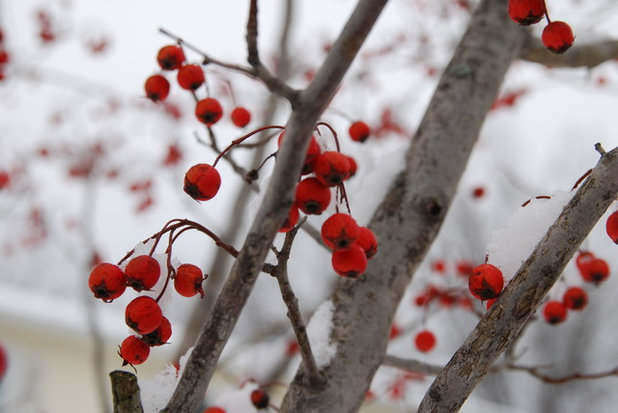
Paintbox Garden
Green Hawthorne(
Crataegus viridis 'Winter King')
With the first snowfall, the red berries of 'Winter King' hawthorne stand out against the snow in a border that's centered on my kitchen window — what a delight. When cutting, I'm careful to avoid the thorns that give this plant its name. I snip off the thorns, then cut branches for dry containers filled with birch twigs, pine, fir and spruce tips.
One of the great landscape trees for year-round interest, 'Winter King' is a good choice for homeowners due to its medium size and rounded form.
USDA zones: 4 to 7
Water requirement: Average; prefers well-drained soil
Light requirement: Full sun
Mature size: Grows to 25 feet high with a greater spread
Planting tips: Use as a focal point; combine with a background of evergreens for best effect in winter.





